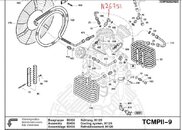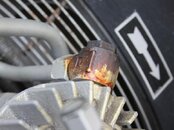No I don't have a 1 PPM calgas or calibrator. Using 10PPM calgas is already very good parameter for CO sensor to be more sensitive. Calibration tell the sensor that 10PPM is equal to "X" electrical value and X/10 is then 1 PPM. Hence do not calibrate with 50PPM calgas if we can............however, I like to test new meter which RAE calibrated using 50PPM calgas at production line and surprisingly they are damn accurate and can read 10 PPM calgas as 10 PPM out of the box.
1 PPM is nothing fancy today for modern sensors. For C0, there is no point to have accuracy better than 1 PPM, so 1 PPM accuracy is more than enough.
RAE or Analox are companies with gas detection background. RAE is big in mining and oil & gas and serving all sorts of industries where accuracy is paramount. Analox while doesn't do broad range of detectors, they are NATO approved for submarine and military diving use. These units are not garage built, that is if you are worried that 1-2 PPM accuracy seems too magical.
If you are also worried of accuracy overall, you should also not trust the Calgas being sold/approved to calibrate these detectors.

It was Swampdiver who tried a few big brands portable CO detector for diving use and fortunately today Analox responded with a portable diver's unit. The sensor technology have improved A LOT and price have became more affordable.
PID based sensor for VOC can read as low as 0.001 PPM , as long as you want to pay for it.
http://www.ionscience.com/assets/files/brochures/Cub brochure V1.3 UK.pdf
If it weren't for a bitch maintaining PID in my kind of tropical humidity ( SwampDiver has PID type instrument ) and its very expensive price, I would have bought a PID to detect VOC gassing off from the compressor oil additives and whatnot. The only other poisons source from our lubricated compressor or even dry one like RIX, is the oil itself, its additives and for oiless RIX, overheating will burn its teflon piston rings and also produce dangerous gas.
Canaries in the Kitchen: Teflon Toxicosis | Environmental Working Group
The same reason we prevent compressor overheating to reduce CO possibility from burnt oil, will in someway ( I hope

) also save us from other possible nasty gases or cocktails produced by the lubricant or teflon or whatever things which when a certain temperature is reached, starts to produce poisons....where our activated carbon ( AC ) may or maynot be able to remove them. We know we have hopcatile to remove CO. Again I am assuming the air fill operator has "common sense" to use a filter cartridge with hopcalite regardless compressor is an electric motor driven.
Since CO comes as the by-product of some combustion/burning and so will other poisons too (which we can't detect cheaply ), CO and C02 meter are the cheapest kind of portable detector one can buy today.
I attached for you a photo of a simple example. That is a fitting on a Bauer 2nd stage from Bauer Mariner using K120 II block and with electric motor. That 90 degrees banjo like fitting has an o-ring so that the bolt can spin when the fitting is being tightened. See the brown residue on that fitting, those are lubrication oil being burnt. The oil can escape out of the fitting because the o-ring which is supposed to have a approx 200 Celcius rating, were overheated beyond 200C and leak it did. Now, even more alarming, assuming the compressor is using Bauer approved oil, which either the synthetic or even the older mineral one, has approx 260C flash point....what does that mean ? It meant the compressor cylinder head temperature at that 2nd stage surely close to 260C.....otherwise the oil stain will be liquid oil like a minor leak and not "fried" oil......in other words we have witnessed a compressor which burned its own lubricating oil and it burnt the oil on the compressor exterior fitting.......can you imagine how hot it is inside the compression chamber itself and what kind of "cooking" have happened ?
That overheated compressor pumps out approx 30 PPM of CO , at least that is the reading I get testing 10 tanks pumped using this compressor before the overheating caused more mechanical problem which put the compressor out of service. What I do not know is, 30 PPM CO at what overheating level ? If 30PPM CO is within 30 minutes of compressor run, by the 2nd hour there will be more CO for sure as above 30 minutes the compressor will be in a more severe overheating state. If I were to have a PID type detector, I probably can read VOC levels.
So anyone refusing say even a 3-5PPM CO level from a tank is making a smart choice as our CO detector can only read CO and not other poisonous gasses , while a burning oil will produce more toxic gas than just CO.
Anyone who can't make their compressor produce zero CO is probably because :
1A - Lazy , lazy to aim the exhaust output of the Honda downwind as wind direction changes
1B - Lazy to shut down compressor while knowing a car has its engine running near the compressor's snorkle air intake
2A - Stingy, stingy to buy extra cooling fans and filter cartridge with hopcalite and a CO detector
2B - Stingy, for those in the tropics or with 30C ambient temperature or more and not owning an infra red thermo gun at least, ( let alone 4 channel data logging one ) to read cylinder heads temperatures
2C - Stingy on proper maintenance of compressor
3 - Not qualified to operate a compressor. How can one be a qualified as an air-fill operator when his/her compressor produced CO and still sell air-fill service ?
4 - Ignorant......this is the most dangerous one...profit above all else attitude

Worse if all 4.......yikes !!
What I to do if without a CO detector at hand is to inspect a dive operator compressor room ventilation system and take a look at their compressor fittings and overall condition and the color of the water condensate from water & oil separator no1 and no 2. I can decide there then to run away or use their service while being very careful.

However, I always carry a CO detector when I travel and I am ultra sensitive when detecting sort of bad air which has no CO reading...........example is a "wet/stale" air from a compressor with a cool operation but overdue filter change. Air without CO can sometime smell too, those smell actually comes from the VNMH so it seems.......:depressed:
New Page 1
"After taste" in air is also detectable to some degree even when it does not smell much or has zero CO reading.
I am hoping the newer PID instruments can detect more gases while costing less. Prices are dropping already, some units of US$7000 is now under US$3000.
The sticky on top of this section called
Compressed breathing air the potential for evil from within has lots of information.
Be safe...........
.
---------- Post Merged at 04:23 AM ---------- Previous Post was at 04:19 AM ----------
Sorry, I cant make my photos stick

Here we go............






